Yeah, Wet Vietnam - Routine Patrol
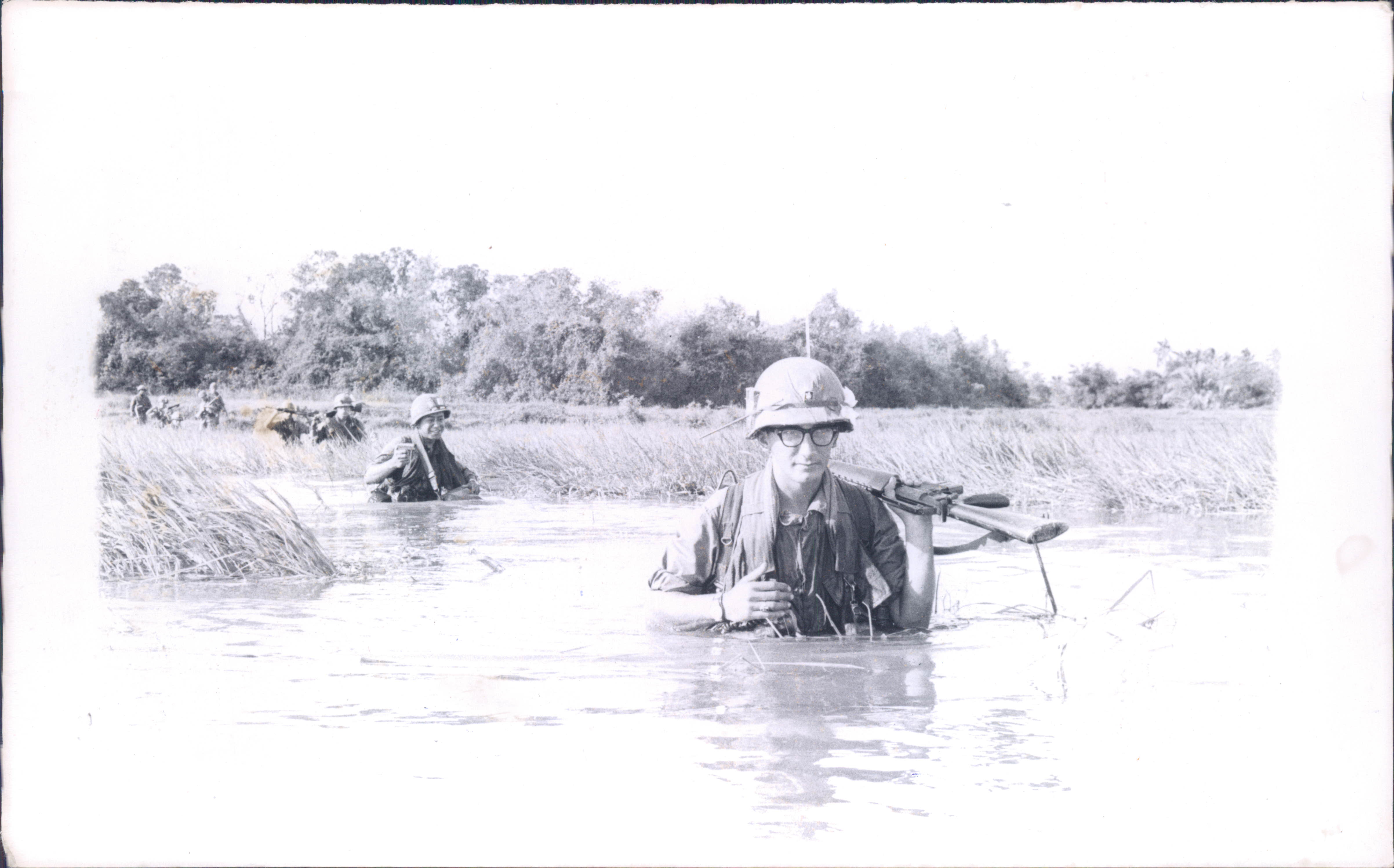
My First Heavy, Costly Operation
It happened on the 12th of July. I had inserted Company A into a area where our Cobra gunships spotted more Vietnamese 'civilians' in the fields than should have been there. Immediately Company A ran into a buzz saw- the farmers were all Viet Cong! A big firefight started right off.
I quickly called for my other two companies - B and C to join the fight. We only had 10 Hueys to shuttle them in with. I finally got them in, but not before I had my first command helicopter got shot up so bad I had to tell them to just put me in the ground so they could go back for another bird. Before it was over 10 of our choppers were hit. And my second command helicopter was shot down too - so I fought the rest of the evening into the night on the ground.
The fight lasted 9 hours. We had tangled with the 269th VC Battalion, at least 300 strong. It was bad. We lost 7 killed, and 23 wounded.
I thought we took the worst of it, but after they retreated into Cambodia where we could not pursue them, agents told me that we had killed at least 30, and they dragged over 100 wounded across the border.
I was all over the place, doing what I knew, from commanding in Korea, was necessary - concentrate all our firepower to supress the Viet Cong fire while inflicting as many casualties on them that we could. While it would have been good had we captured at least 2 or 3 VC, but the shoot out, even into the night, was at a range of 100 to 300 meters, so there little opportunity to take a prisoner.
I didn't think I did any more than what I was supposed to do as a battalion commander, but somebody put me in for a Silver Star. So several days later after we held a Memorial Service for the 7 killed Wolfhounds, General Tillson pinned it on me. Making it my 3d Silver Star over two wars. Here it is below.
This operation happened so quickly that there was no time for the Army photographer from Cu Chi to fly out and film or photo shoot the operation. So there just is one photo saved showing me, and the Memorial Service.

Not mentioned before, was the fact that the 27th Infantry Wolfhound Regiment, was among the first American Army units to occupy Japan after we defeated them. The destruction of the country and its people was widespread, many institutions were severely damaged - including a Catholic Orphanage in Osaka, Japan.
When the first Christmas of 1945 came around, soldiers of the 27th Infantry visited the damaged Orphanage, where the staff, including nuns, were destitute, and there was little food for the orphan Japanese children. The Wolfhounds took up a collection, and, starting that year the soldiers paid for food for the children every year. And every year, taking contributions from the soldiers pay, the orphanage was gradually rebuilt. The tradition has continued for 63 years, from whereever the Wolfhound regiment is stationed - Japan, Korea during its war, Schofield Barracks, Hawaii, and thruout the War in Vietnam.
When I joined the Wolfounds, and became the battalion commander of the 1st Battalion, 27th Infantry, it seemed appropriate for our battalion, in combat, to honor our fallen soldiers by accepting soldier donations in their memory, and send all of them to the Orphanage at Osaka.
The photograph below is a ceremony we held after two of our troopers were killed in action during Operation Kole Kole. The rifles where placed with the helmets of the two men killed and between them is the contribution stand.
The short PDF file below the photograph tells the rest of the story.

The article which was run in the Tropic Lightning Newspaper - the 25th Infantry Division's paper following the Ceremony described in the pdf file on the right. Click on the word Ceremony.
Life for a Battalion Commander - and Wife
Because I had a wife and three children - two of whom - David and Rebeclca - were well old enough back home in Annandale, Virginia watching nightly TV that covered the war in excruciating and nasty detail - which greatly contributed to turning the public against the war - I wrote home as often as I could. Patsy saved all 60 of my letters I wrote her during that year in Vietnam. Much of the operational detail I go into here came from those letters.
Of course there WERE moments when pretty ladies showed up in the field.
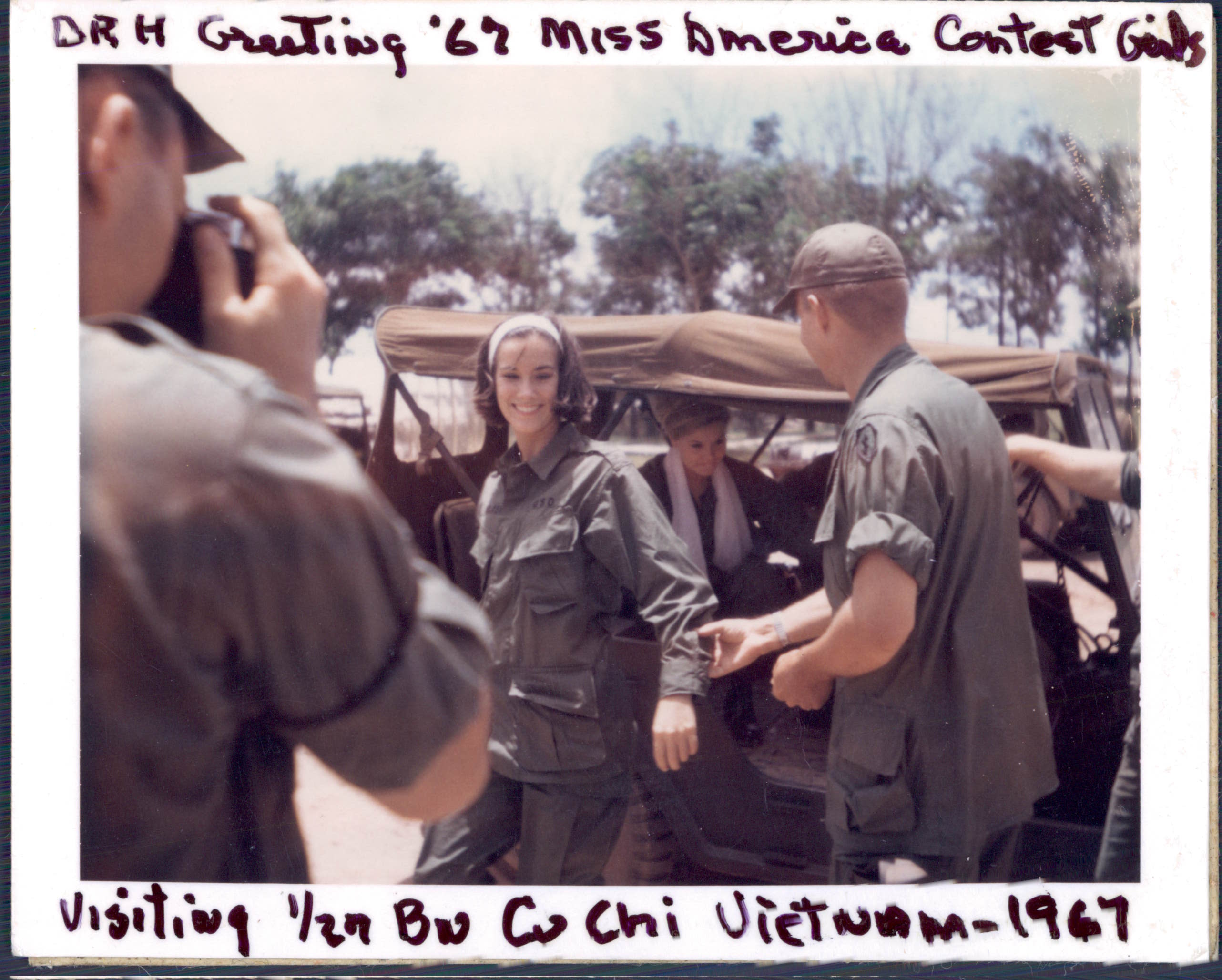
I wanted to reassure them as best I could - and discussed my and my men's living condition often.
One item - I and Ed Peters as battalion commanders were out on operations so much of the time, that we lived no better than the lowest rank soldier. In the rain, mud, and on the ground in the jungle or on rice paddies. If I were lucky I had a pup tent over me at night. If not the cover was a poncho hung on sticks.
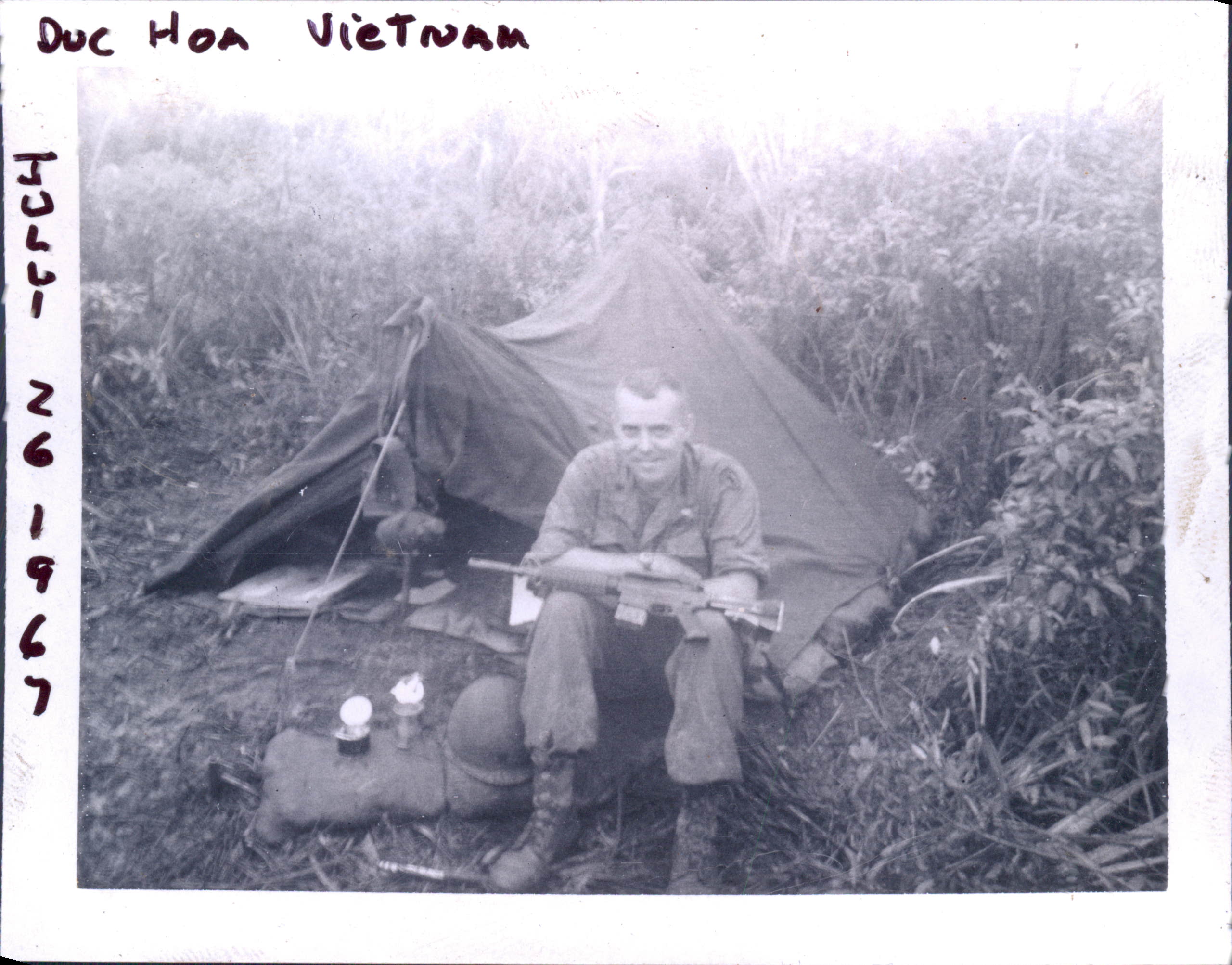
In several letters, the handwriting was red. I explained this way "I am lying on my back on a poncho liner under a tent so low it almost touches my face. My head is propped up on a hard field pack and my clothes are wet; only my feet seem dry. By using a clipboard as my writing table and putting my flashlight under my left armpit I can see to write. But the light is dull red color - I have a red filter in the flashlight so the Viet Cong can't see well."
Much about Patsy's and the kids life, with photos and what they were doing while I was in Vietnam and what Patsy and I discussed by letter is in the Married Life section of this biography.
Contrasted with the very slow mail turnaround time during the Korean War, mail was very efficient and fast to and from Vietnam and the US.
Since the administrative battalion and higher headquarters were in well appointed Cu Chi, while the battalions operated out of rough field camps, it was possible for the units to have some life of their own center at Cu Chi.
For example it was possible to publish a battalion newspaper - 1000 copies being circulated each time. I wrote a front page piece for the troops in the July '67 issue.
The Wolfhound Regiment since they occupied Japan after World War II, had 'adopted' a poor orhanage in Osaka, Japan, and supported it financially ever since. Recurringly the men contributed to it, and the sisters who ran it wrote faithfully to keep the soldiers informed. I was able to read the latest letter thanking the Wolfhounds for the latest sending on money collected in Japan, Korea, Hawaii, and now Vietnam. So long as that 27th Infantry Regiment exists in one form or another, that orphanage will be the beneficiary.
But something else had been started in Vietnam. "Lady Wolfhounds" became the Officer's Wives Club whose men were in the 1st or 2d 27th Infantry outfits. So all the officers wives and their addresses were gathered, and periodically a newsletter about what the outfit was doing in Vietnam, was mailed to all of them. And with the high, and usually annual turnover of all the officers, the ladies were urged to contact each other wherever they lived in the US. Wife Patsy Hughes became the Commander's Wife - so she wrote to - exchanged - letters and photos with many of them.
We Can Ambush Too
My Battalion field base camp was, for a while near the town of Duc-Hoa, off the Oriental River. I sent the sketch, a photo and a description of one of my multi-faceted-operations in mid July to my wife and kids.
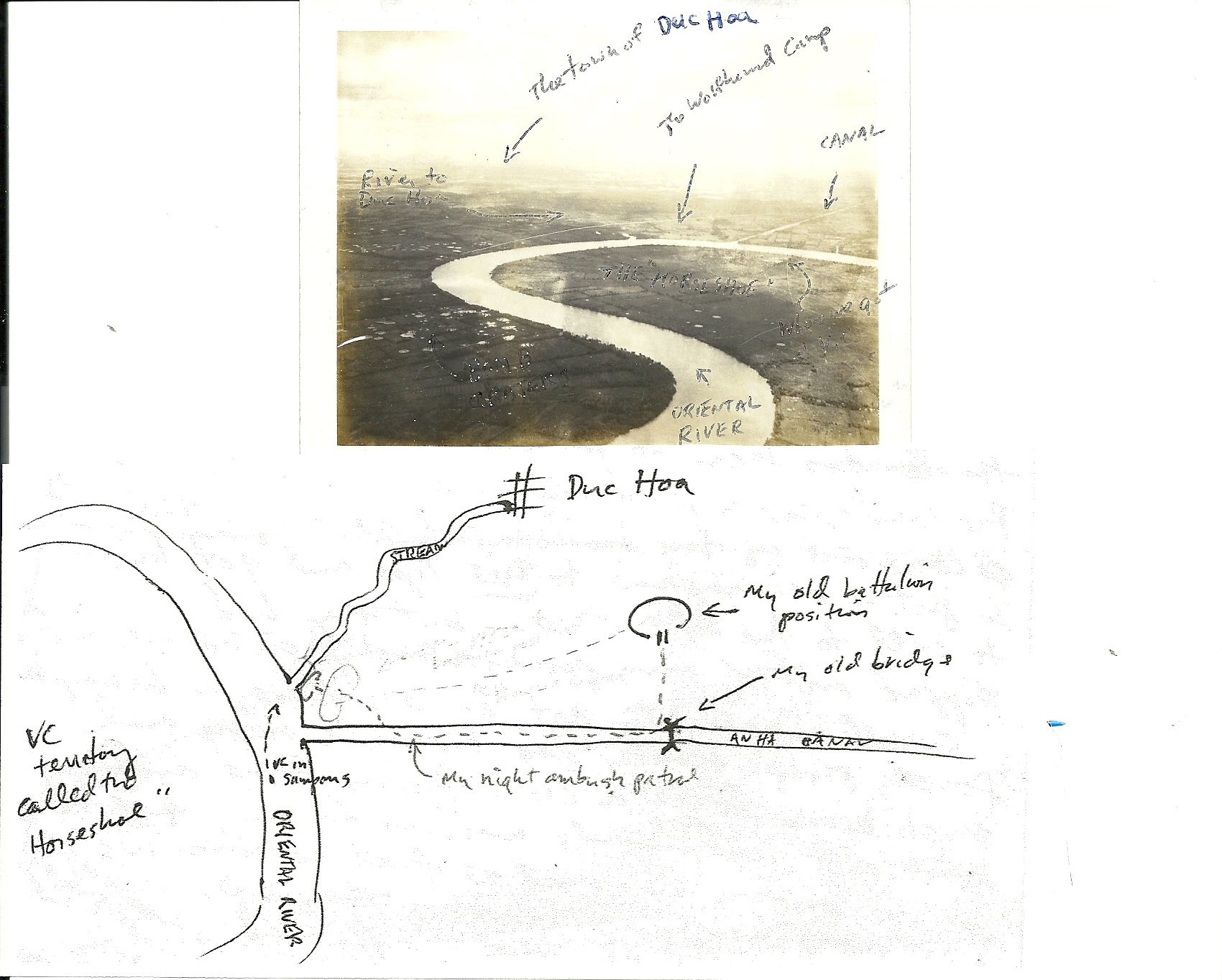
I really had quite a Wolfhound operation going. For I had access to helicopters, gunships, four 27 foot power boats , - my own navy - national police, and ARVN intelligence specialists as we tried to protect Duc-Hoa from Viet Cong shakedown forays into the town.
I sent B Company as an ambush patrol down the Anwa Canal in power boats at 3AM to the intersection of the Canal and Oriental River. A stream - the real water 'highway' connected Duc Hoa to the Oriental.
As morning broke and sampans began to move, three sampans with VC in them came up the stream. Company B captured them without a shot being fired.
I then moved my entire battalion to that intersection.
Then an old woman came down from Duc Hoa in a sampan the next night with a note for my interpreter that said if we would not 'cut off their ears and tongues' that they would bring four "Choi Hois" - willing converts to the government side. I said yes. Next morning in came 5 Viet Cong to give up.
I then, sent Company A in boats into the 'Horseshoe' area where Viet Cong hung out. And put Company B on patrol of the Oriental in boats too. By 10AM we contacted a 4 man VC squad, killed one and wounded one. 2 others escaped. Then I flew in a dog tracker team to follow the blood trail and used a speaker on the Helicopter to tell the wounded man to give up. He did.
With this kind of operation, plus a psyops team and a civil affairs unit, we started catching as many VC as when we only combat assaulted from helicopters.
As I thought, the closer we could integrate our military operation into the local 'civilian' efforts to keep safe, the more we would undercut the un-obstructed actions in population centers by the Viet Cong.
But there just were not sufficient resources or plans to do the amount of the kind of 'counterinsurgency' to make a big difference. EVERYTHING the Viet Cong did had a 'civilian' component.
Into the Mekong Delta
Then we got a new mission. And through it I was able to get an idea what Counterinsurgency by the 9th Division in the waterlogged Mekong Delta was like.
Between the South Vietnamese Army units operating in the Delta - a vast area most of which was under water most of the time and the commander of the US 9th Division, a plan was hatched to saturate a substantial area where the Viet Cong had built up a substantial force protected by the network of waterways - with US heliborne forces working in conjunction with the 'Riverine' units of the US division.
Fighting in the Delta, required lots of well armed motorized boats carrying small US Army units who had learned novel 'Riverine' instead of 'Heliborne' tactics.
The plan envisioned the water-borne 9th Division men together with South Vietnamese soldiers, marines and officers who knew the Delta - to attack the area where two Viet Cong battalions were supposed to be concentrated in, while at least two Battalions of the 25th Division would fly into the Delta and land on dikes and patches of dry land by helicopter setting up a 'blocking position' against which the Riverine force would push retreating Viet Cong, who would, according to their own tactics, run rather than fight. While gun ships would patrol the waterways the Viet Cong would try to get away over by getting into their own boats and sampans. Gun ships to shoot up and sink the boats, loaded with Viet Cong or not - so they would be trapped. And the riverine force would have a killing ground.
My battalion was one of the two 25th Division unit which flew it and blocked. 16 large Chinooks with my 1/27th and 2d of the 14th Infantry from the 1st Brigade flew down there 80 kilometers.
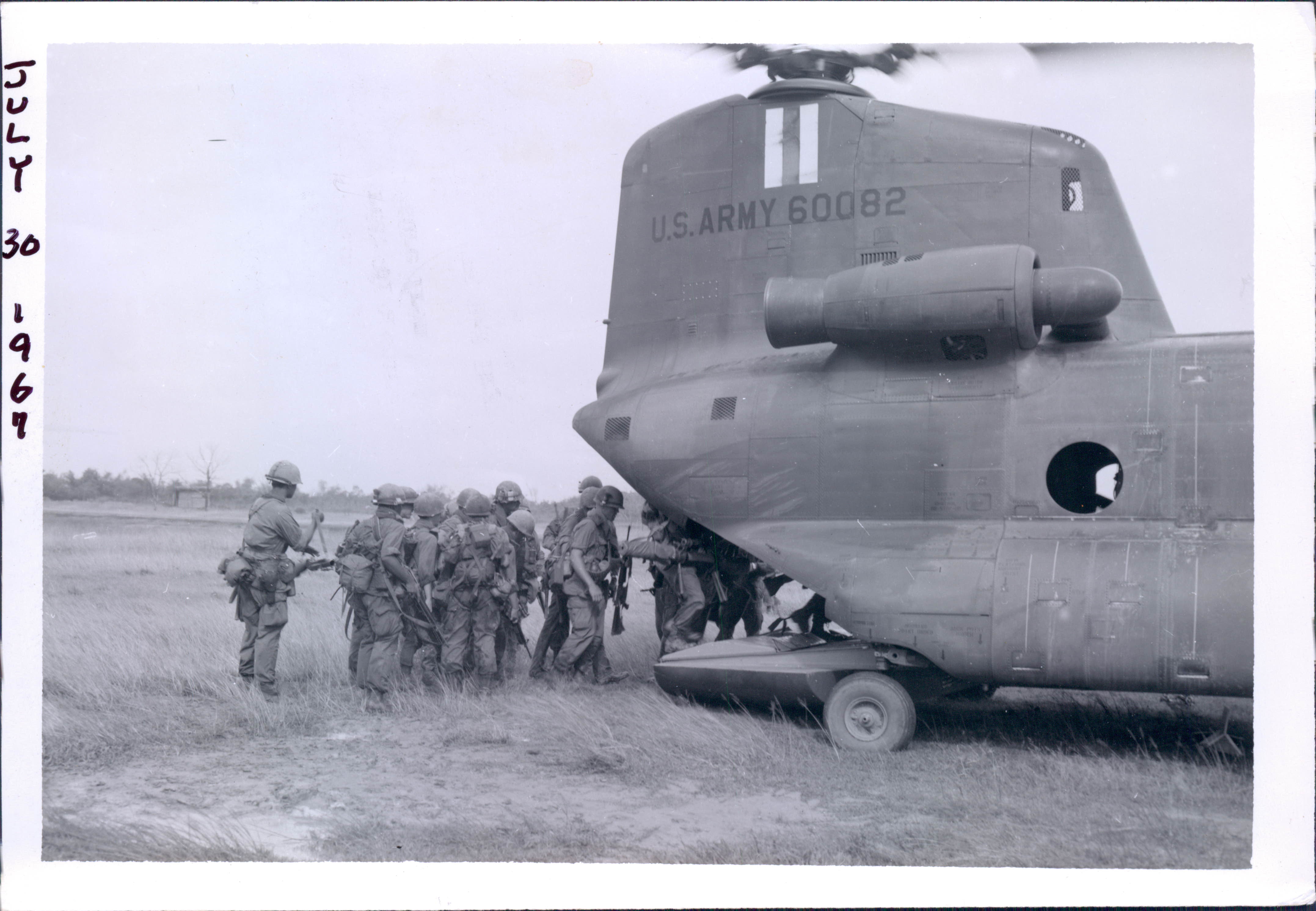

Then there was shuttling with Hueys covered by Cobra gunships to our blocking area. We did it so professionally that we arrived just at dark, where the last five hueys had to land by hand held strobe light.
In the night the Vietnamese Marine unit got hit, but we did not. (did they fear our Wolfhound reputation, which was good in Southern South Vietnam?)
Me mucked through the delta mud the next two days, killed a few VC and captured some weapons. But the Viet Cong battalions never materialized.
Me on a river boat seeking the Viet Cong.

My memory of that operation is dim - for it only lasted about 5 days - and we did our part and inserted platoon sized units where we were told to. We got into very few firing actions, as the Viet Cong fled in many directions and did not attempt to cross our 'lines' but headed east and west to try and escape (we were north of their area.) The gunships seemed to have a field day however, as they were constantly firing at something - either empty boats or ones with a few VC in them.
I had a half hour with Lt Col Blackie Bolduc who was the 9th Division G-3 - operations officer. He was a classmate who also was at West Point teaching French while I taught English.
The Vietnamese senior commanders thought the mission was a success, and awarded the Vietnamese Army equivilant to the US Army Distinguished Unit Citation to our Battalion. More show than substance.
CBS and NBC television crews were with us. Dunno what they reported.
Then we flew back to Cu Chi and told each other how radically different Riverine Warfare was from what we were doing - Jungle, Rice Paddy and Heliborne warfare.
And the next day set out on another typical Search and Destroy mission.
This all happened between July 27th and August 2d.
On the 8th of July I was handed a plaintive letter, carefully but neatly hand written in broken English, from farmer NGUYEN VAN MAI pleading for permission to 'transplant' his rice crop in a sector. Said they were afraid of the machine guns, M113 (personnel carrier) and helicopters that fired at night.
I approved what I could. The price of war for the rural South Vietnamese.